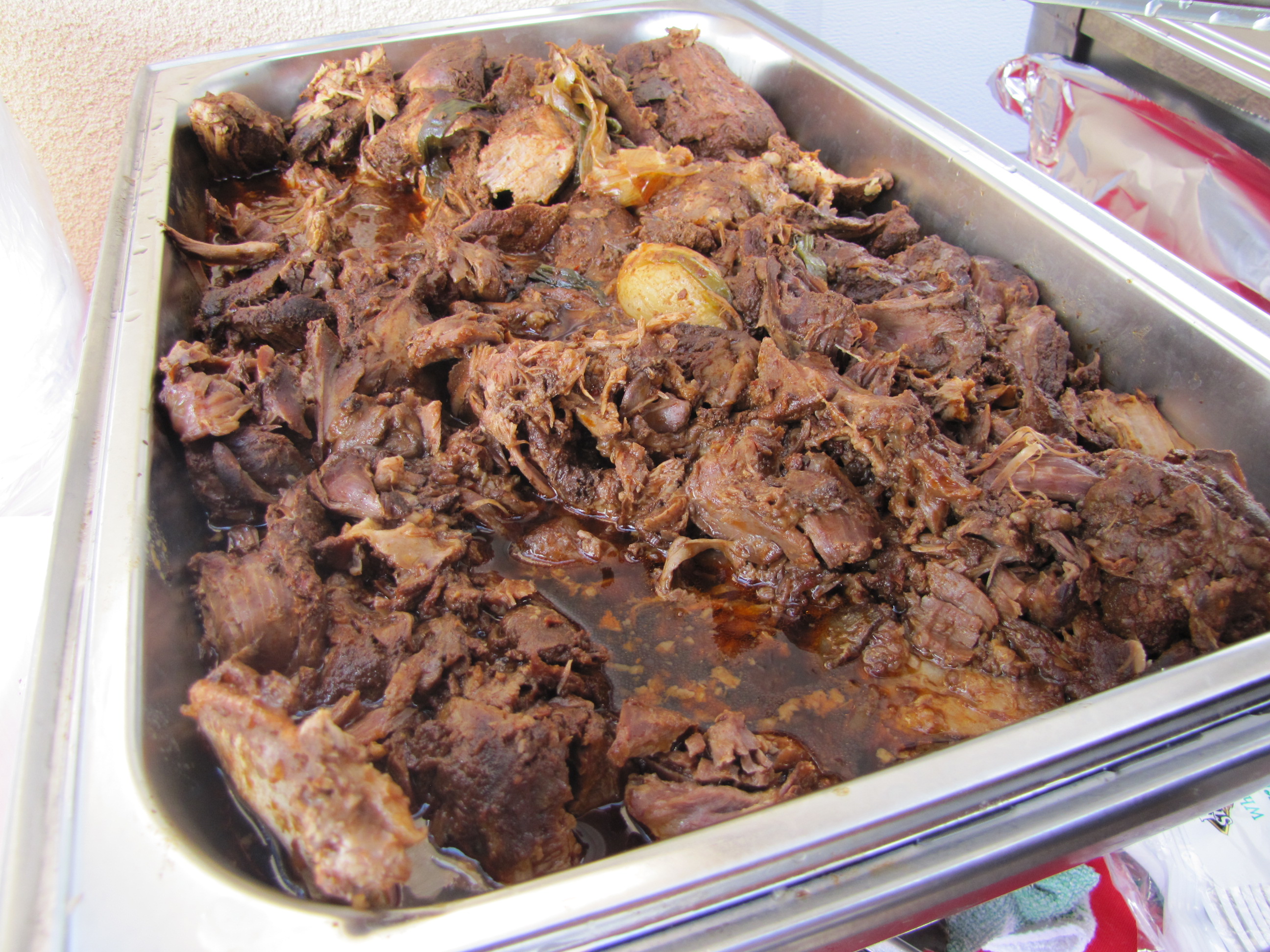[dropcap size=big]T[/dropcap]he eggshell yellow house off Long Beach Boulevard doesn’t stand apart from its Compton neighbors; there’s nothing to suggest that a secret guarded for more than 100 years survives between its walls, with the last person who knows how to unlock it.
His name is Juan Garcia, the owner and chef of Goat Mafia. A fourth-generation birriero born in Ciudad Guzmán, Jalisco, Garcia was raised in this same Hub City home after his family came over to the U.S., shortly before his second birthday some 32 years ago.
To know his story, you’ll need to go back to the early 1950s to his hometown of Tamazula de Gordiano, Jalisco, when his grandfather first fell in love with his grandmother. To ensure the couple’s future, her stepfather passed on the birria recipe he’d been preparing and selling successfully throughout his life. A family recipe passed down to him from generations past. In a state rich with competing birrerias, the recipe was only revealed to kin.
In time, Juan’s grandfather passed the same recipe on to his own two sons, who found success with it in Jalisco and South Los Angeles, respectively. When Juan’s father, a carpenter by trade who sold the birria in his off hours from the same purple Ford Ranger Juan still drives, reached the end of his life, he stated a goal of passing the recipe on to Juan’s sister, before it died with him. But time ran out.
Garcia now prepares this same recipe himself in a clay pot in his kitchen, making it available to birria fans through Goat Mafia’s catering arm, events and sporadic pop-ups.
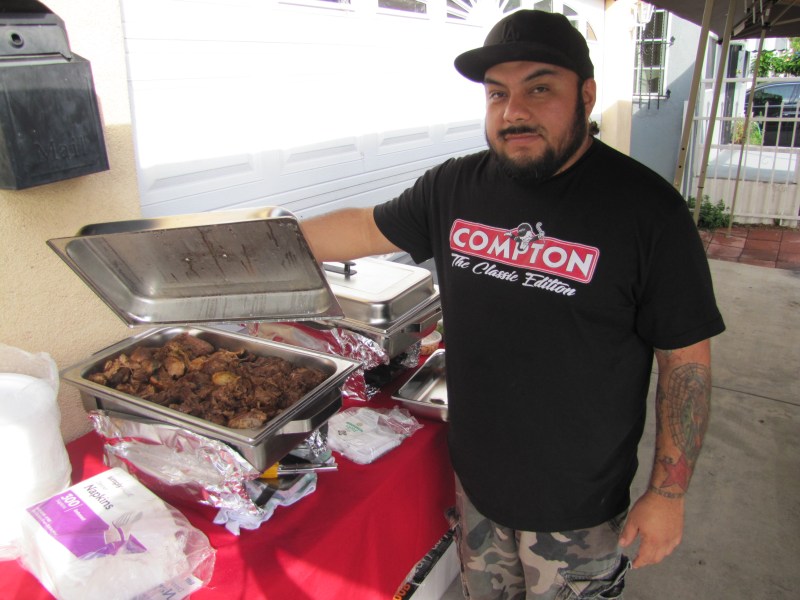
“I undertook the task of learning it because no one else was stepping up,” Garcia tells L.A. Taco. “I’m the only one who can prepare this recipe. I did it to honor my father. If the recipe ends with me, his legacy and my grandfather’s legacy is going to be gone.”
Although a job at Pizza Hut early in life once made him swear off the hospitality business, Garcia eventually leaned on his mother and relatives in Jalisco to revive the family’s birria. Following stints in plumbing, construction and office cleaning, he took stab at his own food truck, later attending LA Harbor College’s Culinary Arts program, after which his vision started falling into place.
“Going to culinary school, learning French, German, and Asian techniques pushed me more toward my own culture,” he says.
[dropcap size=big]T[/dropcap]o prepare Goat Mafia’s birria, Garcia uses whole, pasture-raised goats from an unidentified farm whenever possible. And grain-fed goat from a neighborhood carnicería when it has to be. Either way, it’s always prepared with chivo.
Goat Mafia even has a catchphrase: “Si no es chivo, no es birria.” A phrase he knows can draw controversy among people raised on different incarnations of the dish, but one that best explains his passion for it, as well as for the legacy of his own regional traditions.
Arranged into a taco, the chivo takes on more divine qualities.
He traces apocryphal origins of birria back to the introduction of goats from Spanish colonizers and the local population’s subsequent need to cull these omnivorous, land-devouring beasts. By eating them, of course. But only after masking the meat’s gamier notes with spices.
“To me, birria has to be goat,” Garcia says. “That is the No. 1 ingredient. Then it’s the chiles. Then the consomé coming from the same animal as you use in your birria. That’s true birria to me.”
RELATED: Support Great Local Food Journalism Like This ~ Become a Member Today!
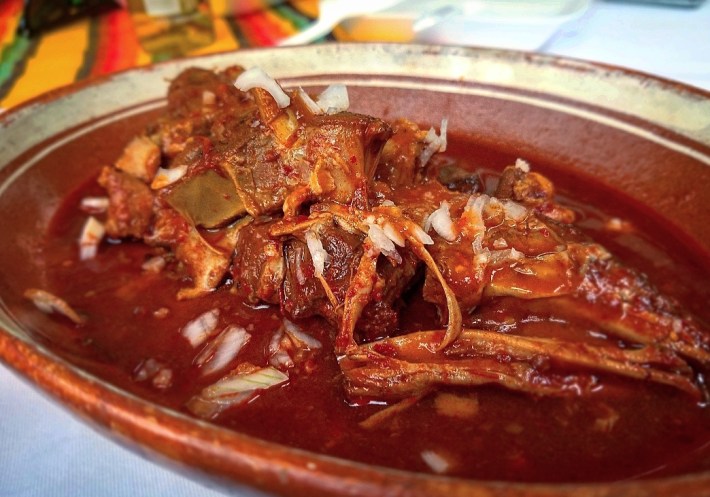
He understands this stance won’t jibe with everyone. His own explorations of birria’s origins frustratingly hinge more on folklore than fact. Still, this dedication to chivo is gastronomic as much as it is cultural, as he cites goat’s specific and unique flavors as the singular ingredient that makes it what it is.
“I think birria with beef and its broth is no different than carne en su jugo or carne con chile, because it tastes similar,” he says. “I know some people don’t agree, and I don’t want to put anyone down. If I were to find out tomorrow that original birria is made out of beef, then that’s what it is.”
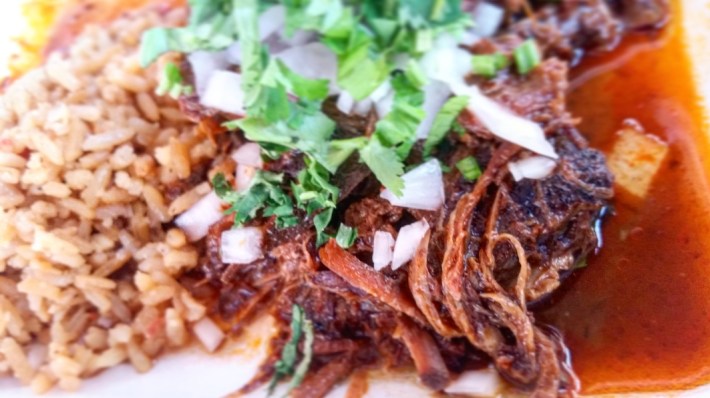
[dropcap size=big]T[/dropcap]hough he still keeps certain ingredients of the recipe close to his chest, Juan discloses a handful that go into the dish: dried pasilla and guajillo, among other unnamed peppers; chocolate, cinnamon, and oranges, preferably his uncle’s from next door, as fresh fruit makes a major difference. Ginger is one of the less common birria elements he’ll divulge.
As Garcia makes the birria, he covers the slow-cooking stew with a thick layer of pork. Like maturing spirits in wood, the technique transfers much of the goat meat’s barnyard funk into the pork, as the pork’s own fatty, flavorful oils drip their way back into the goat broth.
“When you taste the pork, it’s goatier than the goat,” he says.
Naturally, so much chatter about eating goat and pig and cow makes us hungry. It’s 9:30 am on a Sunday and a long front-yard table set with bowls of quartered limes, diced onion, shredded cilantro and a bright red salsa is starting to fill with friends and family, as Juan’s mother stands close by, making tortillas.
RELATED: Portable BBQ: Ray's Texas BBQ in Huntington Park has a Two Pound Burrito That's a Game Changer
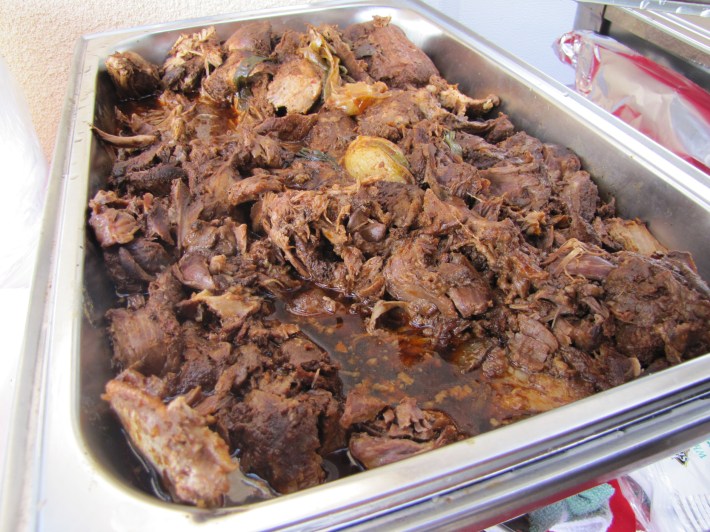
The birria, which can take Juan anywhere from six to nine hours to cook, depending on the goat’s age, is spooned out of steel, Sterno-fueled warming trays with a side of beans and rice. Before rolling the meat into the fresh tortillas, we taste it on its own.
The birria isn’t noticeably rich or choked with spices, like many we’ve tasted. The flavors are cleaner, more straightforward and subtle; nuanced with a slightly sweet backbone we’re inclined to pin on the chocolate. It's not a soupy, shredded slurry, but a showcase of the star protein, which lands on the plate in tender, substantial cuts.
'My goal was to have Jonathan Gold taste it.'
Arranged into a taco, the chivo takes on more divine qualities. The textures of moist muscle harmonize with delicate ribbons of fat, collagen, marrow from the shanks and skin that’s fallen from the rib section during the long cooking process.
[dropcap size=big]I[/dropcap]t’s easy to believe we’re eating a purist’s birria. But Garcia dismisses words like “authentic” while negotiating a pull between the perfection this one recipe and other interests, like Asian cuisine, especially after a recent vacation to Japan “changed him.” Garcia even once made a version of his birria with a stout that he just had to call “beer-ia.”
“The basic universal birria recipe is here, with just a few minor additions and a certain technique. But people should feel free to experiment. That’s what cooking is about. It’s hard to be ‘authentic.’ I’m not in Jalisco and there might be someone over there that says this is not birria, you know?”
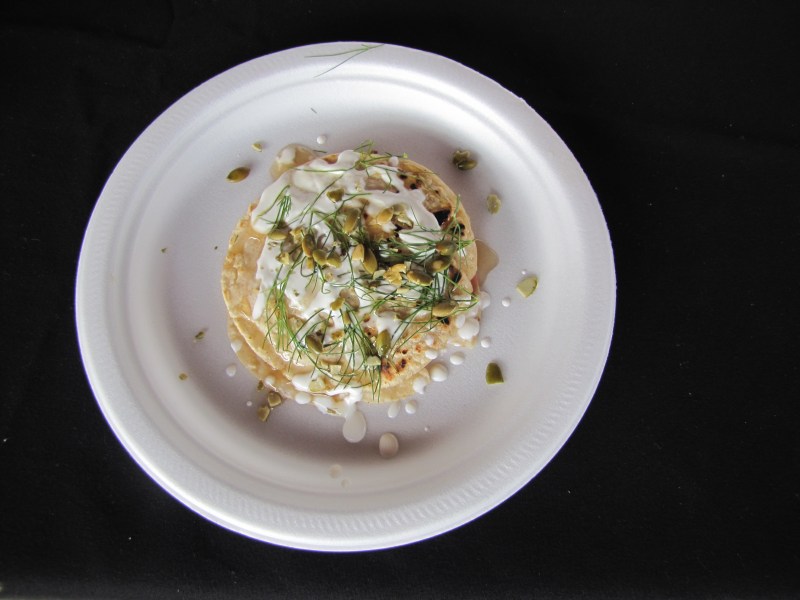
Next, he serves us a dill-sprinkled mulita stuffed with a mild, hand-whipped goat cheese, quesillo and beets, topped with crushed, toasted pepitas, agave and Jocoque. He calls this a “Chivadilla” and plans to debut it on October 21st at the SoCal Cerveceros home brewing and food event in Lincoln Heights.
To me, as a half-Slav with longstanding dreams of making birria-borscht at home, these famously well-coupled flavors in a Mexican format are nothing short of a revelation.
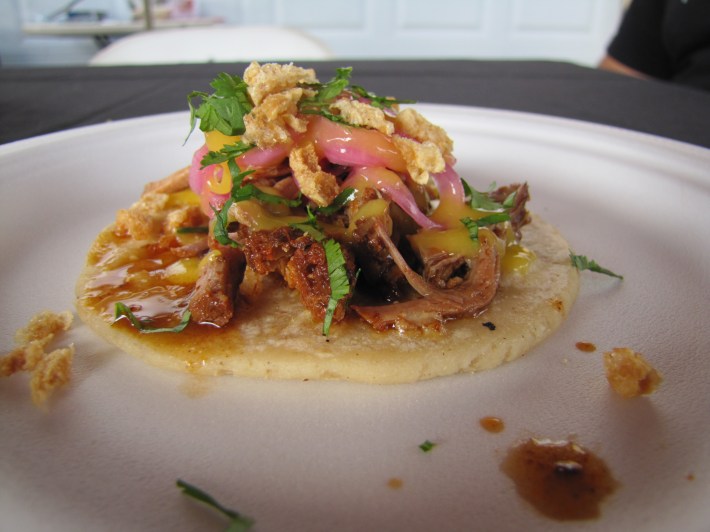
[dropcap size=big]N[/dropcap]ext comes a taco filled with the same soft pork that was covering Juan’s birria, topped with pickled onions, mango, habanero puree, and crushed chicharron on top. The goaty flavors are noticeably imbued in the pork, as promised; the only thing missing from the mouthwatering, texturally sound taco is a clever portmanteau combining pig and birria. “Hog-lisco” is maybe the best we can do at the moment.
We down a cup of consomé and order a second helping of goat, then I ask Garcia’s what his wildest dreams are for Goat Mafia. He answers: “My goal was to have Jonathan Gold taste it. Especially after reading his review of El Parian. He was a hero to all of us. When he passed, a piece of me was torn apart.”
Getting just a little choked up, he avows, “If I can cook my food the way I want to, with no rules, and be able to feed my family, that would be it. I don’t care if I’m in the ranks of Michelin-starred restaurants or selling out of my driveway, if I can put food on my family’s table, I’m good.”
After saying goodbye, we hit the road. The car starts on K-DAY pumping the tail-end of a song from Dr. Dre, who has arguably done more to put Compton on the world map than anyone. When the song is over, we catch YG on REAL 92.3 FM and remember something Juan said right before we left; almost an afterthought.
“My dream is for the world to know that you don’t have to be a rapper to come from Compton and make it,” he says.
RELATED: Hadley Tomicki On El Parian, LA Taco Archive, 2009.
